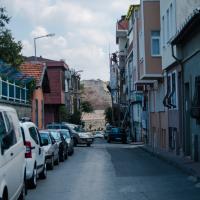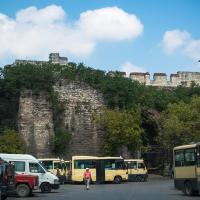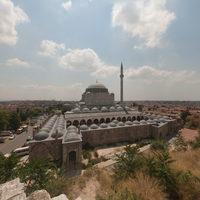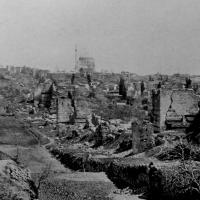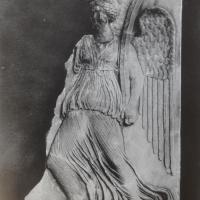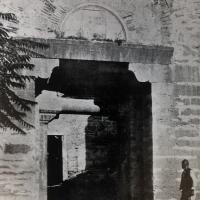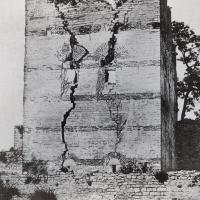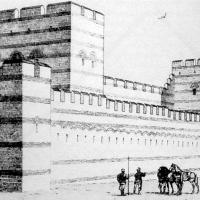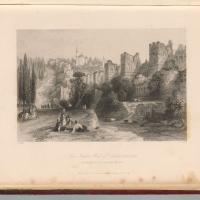The Theodosian Walls, Theodosianon Teichos
Emperor Theodosius II (408-50)
413 CE (with subsequent interventions)
Description
Based on the growing needs for the constantly increasing population of the fifth-century Constantinople, the emperor Theodosius II together with the praefectus Anthemius initiated the construction project of the capital’s new defense system for the capital.The promontory that extends to the Sea of Marmara, surrounded by the Golden Horn, the Bosporus from three sides, was planned to be cut from the west by the fortification system that lied between today’s Balat and Yedikule.
Although no reliable archaeological evidence survives today, the so-called ‘Theodosian’ land walls are believed to be the second or the third defense system of Byzantium, the city later will be named as Constantinople. Although described by Xenophon (Anabasis vii.1), Cyril Mango argues that the acropolis of the Megarian colony of Byzantium, situated under today’s Topkapi Palace, was not fortified, at least until the time of Septimus Severius, since it was already built on a steep cliff (Mango et all, ODB; Mango 1985; Van Millingen 1899: 5). In the first decades of the fourth century, Constantine I is possibly the first ruler to set the foundations of the first fortification system of the late Roman city of Constantinople, of which remains is once associated to the wall fragment that was preserved in Isa Kapisi (Mango 1985).
As opposed to the Constantine walls, the Theodosian land walls survived intact, as they remained as the main urban limit markers for centuries, and thus constantly repaired against the enemy attacks. The Theodosian land walls required three main defense units, namely the mega teixos – the main wall, the proteichos –the outer wall, and the moat system. Consisted of ninety-six towers, placed approximately hundred meters away from each other, the construction of the land walls has started in 412, and is believed to be completed a little more than two months according to the historical sources (Speck 1973: 135-78; Müller-Wiener 1997: 287). From the three dedicatory inscriptions, of two still survive intact in Mevlevihane Kapisi, name the emperor Theodosius as the benefactor together with the eparch Constantine, and repeats the construction period as ''sixty days'' (Van Millingen 1899: 47). Codex Theodosianus, the law codes compiled under the reign of Theodosius II, provides us with plentiful detailed information about the legislations concerning the maintenance of the towers (Codex Theodosianus XV 1.51).
Due to the harsh winter conditions and the Hun attacks, already in 447 and 554, the defense system has undergone two serious restoration campaigns, undertook by prefecti prates Constantius and Spatharios Narses under the reign of Justin II (Müller-Wiener 1997: 288). A century later, in 626, the Avars’ siege, in 668 and 674-80, the Arabs’ siege were other occasion when the land walls had to be strengthened (Müller-Wiener 1997: 288).
In the eight-century, the emperor Leo III and Constantine V had start levying additional taxes to be able to meet the expenses for the land walls’ restorations (Müller-Wiener 1997: 293). Beside the enemy attacks, the historical evidence suggest that another major threat to the walls seems to be the devastating earthquakes that constantly hit the capital, especially in the eleventh century (Müller-Wiener 1997: 293).
Possibly, after the eleventh century, the direction of the walls was changed drastically by Manuel I Komnenos who by extending the portion of the land walls in Blachernae, and started to construct additional structures (Müller-Wiener 1997: 293). Situated in the same portion of the walls, Tekfur Sarayi is believed to be constructed under Mikhail VIII Palaiologos (1259-82), who undertook again a major restoration project following the Latin occupation of the city (Mango, ODB).
Map Location
Bibliography
- Ahunbay, Metin, “İstanbul Karasurları: Tarih, Yapım Tekniği ve Koruma”, Karasurlarının korunması için uygun yaklaşım ve yöntemler sempozyumu, Istanbul Metropolitan Municipality, (Istanbul, 2007): 28-31.Baker, B. Glanville, The Walls of Constantinople (New York, 1975).
- Caratheodory, C.E. and G.A. Demetriades, Plan archéologique des murailles de Constantinople du côté de la terre (Istanbul, 1881).
- Crow, James, The Infrastructure of a Great City: Earth, Walls and Water in Late Antiquity Constantinople (Leiden, 2007).
- Dallaway, J., “An account of the Walls of Constantinople,“ Archaeologia 14 (1803): 231-43.
- Dirimtekin, Feridun, “Les murailles d'Istanbul,“ Corsi Ravenna 12 (1965): 211-24.
- Foss, Clive and David Winfield, Byzantine Fortifications: An Introduction (Pretoria, 1986), 41–77.
- Foss, Clive, “Anomalous Imperial Inscrip- tions of the Walls of Constantinople,” in Studies Presented to Sterling Dow, Greek, Roman and Byzantine Monographs 10 (Durham, 1984): 77–87.
- Kalkan, H. and Sencer Sahin, “Ein neues Bauepigramm der theodosischen Landmauer von Konstantinupolis aus dem Jahr 447,” Epigraphica Anatolica 23 (1994): 145–56.
- Lebek, W.D., “Die Landmauer von Kon- stantinopel und ein neues Bauepigramm,” Epigraphica Anatolica 25 (1995): 107–54.
- Lietzmann, H., Die Landmauer von K'pel Vorbericht über die Aufname 1928 AbhBerlin 1 (1929) FuF 5 (1929): 169-70.
- Meyer-Plath, B. and A. M. Schneider, Die Landmauer von Konstantinopel (Berlin, 1943).
- Peschlow, Urs, “Mermerkule-Ein spätbyzantinischer Palast in Konstantinopel,” in Studien zur byzantinischen Kunstgeschichte. Festschrift für Horst Hallensleben zum 65. Geburtstag (Amsterdam, 1995): 93–97.
- Schneider A. M., Meyer-Plath B., Die Landmauer von Konstantinopel II, Walter de Gruyter, [Denkmäler Antiker Architektur 8]: Berlin 1943.
- Ahunbay, Zeynep and Metin Ahunbay, 'Recent Work on the Land Walls of Istanbul, Tower 2 and 5,' DOP 54 (2000): 227-39.
- Asutay-Effenberger, Neslihan, Die Landmauer von Konstantinopel-Istanbul: historischtopographische und baugeschichtliche Untersuchungen (Berlin, 2007).
- Van Millingen, Alexander, Byzantine Constantinople: The Walls of the City and Adjoining Historical Sites (London, 1899).
- Müller-Wiener, Wolfgang, Bildlexikon zur Topographie Istanbuls. Byzantion – Konstantinupolis – Istanbul bis zum Beginn des 17. Jahrhunderts (Tübingen, 1977).
- Papadopoulos, J., Les citernes à ciel ouvert et le fossé des murailles (Recherches Byzantines: 1919).
- Sevcenko, Igor, 'The Inscription of Justin II's time on the Mevlevihane (Rhesion) Gate at Istanbul', Zbornik Radova Vizantoloshkog Instituta 12 (1970): 241-47.
- Tsangadas, C.D., The Fortification and Defense of Constantinople (Boulder, Colo, 1980).
For a recent report on the conservation issues about the Land Walls, prepared by Figen Kıvılcım Çorakbaş, Asu Aksoy and Alessandra Ricci, See the following link: http://media.wix.com/ugd/d64f47_755c6d538e324926b2c9d9d5fce0f8b4.pdf








